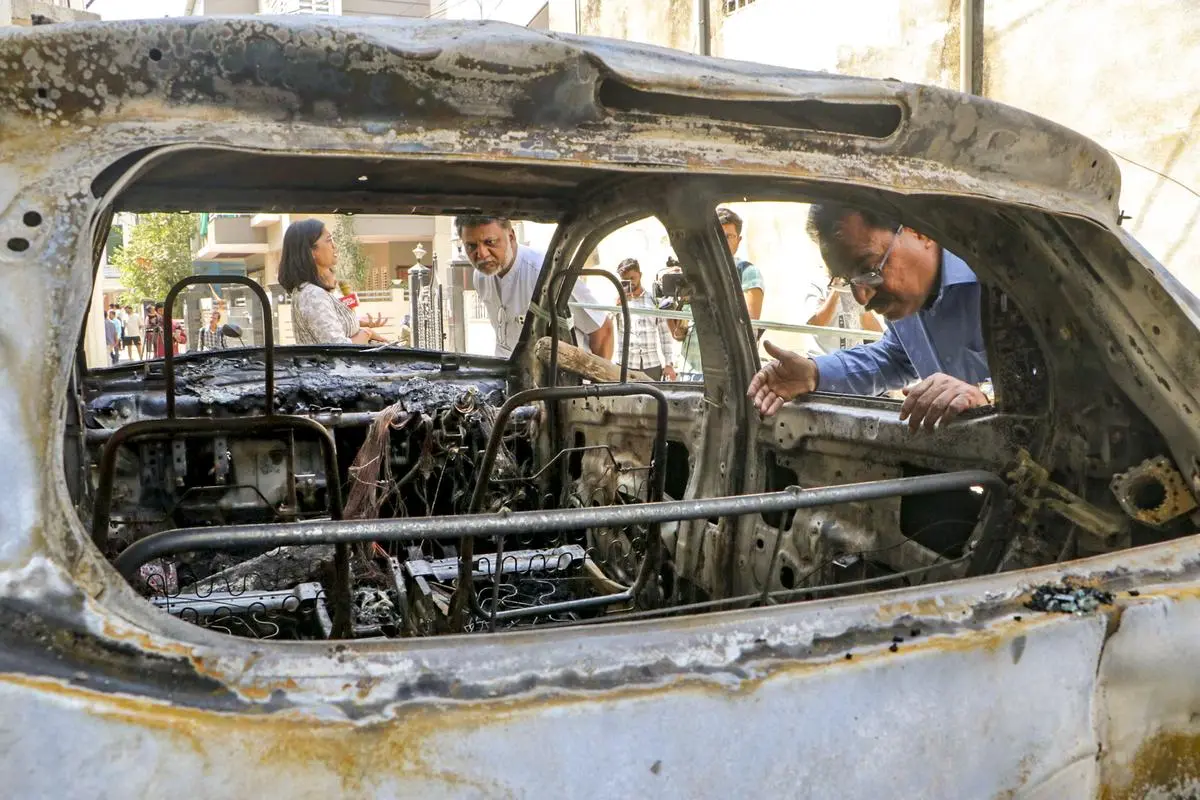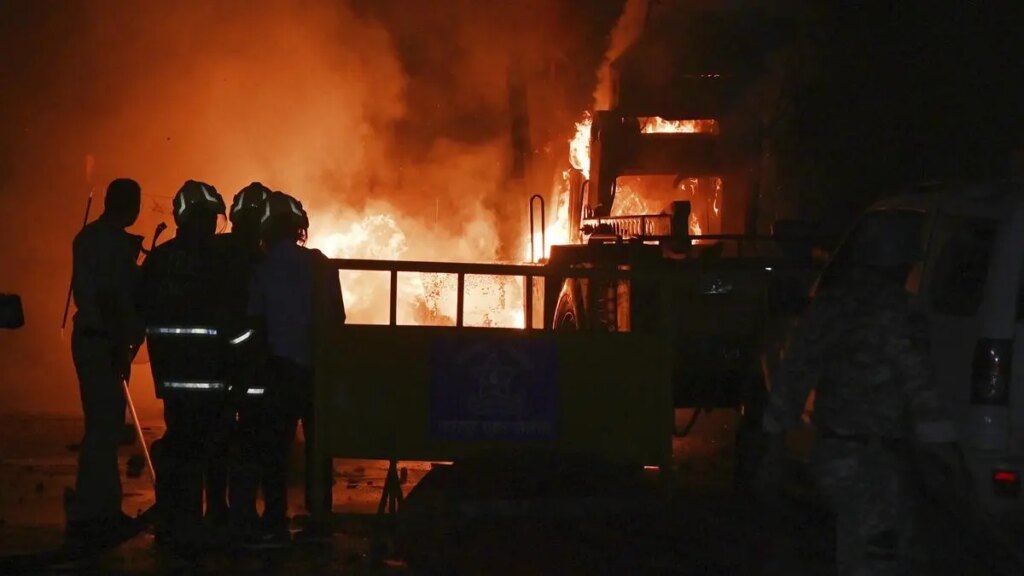A riot broke out in Nagpur, Maharashtra’s second capital and the headquarters of the RSS, on the evening of March 17. Hours earlier, a rally had been held in the city’s Mahal area by the Vishva Hindu Parishad (VHP) and Bajrang Dal, seeking the destruction of the Mughal Emperor Aurangzeb’s tomb located in Chhatrapati Sambhajinagar, during which the protesters had burnt an effigy of Aurangzeb. Rumours, however, spread that the holy Quran had been desecrated, leading to the riot.
Maharashtra Chief Minister Devendra Fadnavis, who is also the State Home Minister, and Union Minister Nitin Gadkari, both of whom are from Nagpur, appealed for peace and urged the people not to pay attention to rumours. But the appeal lacks weight, given that it is the BJP’s various leaders who have persistently stoked communal tension over the past month with their provocative speeches.
On March 9, in a statement made in the Legislative Council, Fadnavis had said that he supported the demand for demolishing Aurangzeb’s tomb, but that it should be done in accordance with the law. “It [the tomb] is part of the Archaeological Survey of India. It is a protected site,” he said. After the riots, Fadnavis blamed the Hindi film Chhaava for the violence.
Police in Nagpur have reportedly conducted a “combing operation” to arrest 80 people involved in the riots and imposed a curfew in some parts of the city. The police are checking 55 social media accounts that had allegedly spread communal messages; over 1,800 social media accounts have already been scrutinised.
Also Read | Chhaava and the mythology of anger
The Bollywood film Chhaava, based on the life story of Shivaji’s son Sambhaji, has been topping box office collections over the past two months. Right-wing politicians have been quick to latch on to the film’s depiction of the supposedly brutal killing of Sambhaji ordered by Aurangzeb to air shrill demands for the demolition of Aurangzeb’s modest tomb. Aurangzeb, who spent 27 years in what is now Maharashtra, fighting the powerful Maratha empire founded by Shivaji, died on March 3, 1707, at Ahmednagar (now Ahilyanagar). His body was carried from Ahmednagar to Khuldabad, a village near Khadaki (known as Aurangabad until its name was changed to Chhatrapati Sambhajinagar in 2024), in accordance with the emperor’s last wishes. Khadaki was the home of some Sufi saints with whom Aurangzeb had developed a connection in the last years of his life. Unlike the other Great Mughals, Aurangzeb did not wish for a grand tomb, and his burial place is a modest affair.
The procession that sparked the riots was the last in a series of rallies in the State since February demanding the demolition of Aurangzeb’s tomb. The banners carried in these rallies threatened that “if [Aurangzeb’s] tomb is not removed, Hindus would do karseva at the tomb as they had done at Babri Masjid”. BJP leaders addressed some of these rallies. In Pune on March 16, T. Raja Singh, a BJP MLA from Telangana, said: “The Hindus in Maharashtra want Aurangzeb’s grave to be erased. I have only one resolve now—to make India a ‘Hindu Rashtra’ and remove Aurangzeb’s grave.”
On March 14, Maharashtra’s Minister for Fisheries and Ports Development Nitesh Rane (of the BJP) went so far as to say: “Those who want Aurangzeb’s tomb to be protected should go to Pakistan. There is no place for Aurangzeb lovers in Maharashtra.”
After the riot, opposition parties demanded Nitesh Rane’s resignation for his provocative speeches and held a protest on the steps of the Assembly on March 18. But ruling coalition members started a counter protest on the Assembly premises demanding the tomb’s demolition. The Chief Minister’s remark in the Legislative Council and the latest protests by ruling coalition members makes it clear that the demand has the blessings of the ruling dispensation.
Row overshadows Budget session
The issue rocked the Assembly as soon as the Budget session started on March 3, stealing focus from the State’s deteriorating financial condition. In fact, it came as a face-saver for the ruling Mahayuti coalition, which has been on the back foot over the resignation of Food and Civil Supplies Minister Dhananjay Munde in the case of the brutal murder of a sarpanch in Beed. Deputy Chief Minister Eknath Shinde reacted to Samajwadi Party MLA Abu Azmi’s comment that Aurangzeb was a good administrator by demanding his suspension from the House.
Besides deflecting criticism of the Mahayuti government, the issue has turned out to be a deeply polarising one with more and more politicians jumping on the bandwagon.

A car vandalised in the violence in Nagpur on March 17.
| Photo Credit:
PTI
The Congress party added another perspective to the demolition demand. The party’s State chief Harshwardhan Sapkal alleged that the RSS and its affiliates wanted to delete the history of Maratha warriors by demolishing Aurangzeb’s tomb. “Aurangzeb was a cruel emperor. But he was also a brave warrior. He had to spend 27 years of his life in Maharashtra to defeat Shivaji’s Maratha empire. But Aurangzeb failed and died in Maharashtra. His tomb is proof of the courage and victory of Maratha warriors. The RSS wants to erase this history. Removing Aurangzeb’s tomb is the first step towards it.”
The historian Indrajit Sawant expressed a similar opinion: “Preserving the tombs of Aurangzeb or Afzal Khan [17th-century lieutenant of Adil Shah from Bijapur] is proof of Maratha victories. These provide inspiration for generations of Maharashtra youths that their ancestors never bowed before cruel warriors. Asking to remove these tombs is nothing but asking to forget the glorious past of the Maratha empire.”
Police in Khuldabad have, meanwhile, started taking precautionary measures at the tomb site. Sixty personnel of the State Reserved Police Force and three police officers have been deployed and visitors are being allowed in only after scrutiny of their identity cards at the entrance to the site.
Rise in harassment of Muslims
In recent months, Maharashtra has seen increased harassment of Muslims by right-wing mobs as well as police and administration. In Malvan of Sindhudurg, a minor boy was sent to a juvenile home for raising slogans against India after a match with Pakistan in the Champions Trophy; his parents were arrested and the family’s scrap shop was demolished by civic authorities.
In another incident, also in the Konkan region, there was trouble after a Holi procession went past a mosque. On March 17, T. Raja Singh made a provocative speech at a rally held in Kolhapur.
That the communal temperature is rising is clear, but the question being asked is about the need for it at this point.
Kumar Saptarshi, a social activist, said: “It is widely believed that the RSS or BJP pushes an aggressive Hindutva agenda before key elections. But now there is no election coming up in Maharashtra. The BJP has had a big win in the State Assembly election. Then why raise these issues now? It means the RSS and BJP want to make Maharashtra as polarised as Madhya Pradesh and Gujarat.”
Also Read | How religion became a cultural weapon
Suresh Dwadashiwar, a veteran journalist from Nagpur, said: “Maharashtra has been a progressive State for many years. It has resisted the communal ideology of the BJP. But now the BJP has a complete grip on the State’s politics and is using it to polarise society.”
The recent communal tensions have certainly helped the State government to avert criticism over farmer suicides, the increasing cases of atrocities against women, and other pressing issues. On March 13, Kailas Nagare, recipient of the Young Farmer Award in 2020, died by suicide in Buldhana, Vidarbha. His suicide note said: “I was asking for water for irrigation. I observed a fast for 10 days in December. I was assured by the government that water would be released through canals. But that has not happened.”
Several other deaths by suicide have taken place in the past one month. In Beed district, Dhananjay Nagargoje, a temporary teacher in a school, died by suicide on March 15; he had not got his salary for 18 years.
Professor Sanjiv Chandorkar, a social economist, said the communal tension was engineered to shift attention from these incidents. “Inflation, an inaccessible healthcare system, and falling agricultural incomes are the real issues on the ground. The financial slowdown is making life hard for common people. So, there is increasing frustration among the lower strata. The communal tensions are diverting attention from these issues. Whether these are planned or not is for the police to investigate. But these incidents show failure of governance in Maharashtra.”
Source:https://frontline.thehindu.com/the-nation/communalism/nagpur-riots-maharashtra-communal-polarisation-aurangzeb-tomb-controversy-chhaava/article69343997.ece

